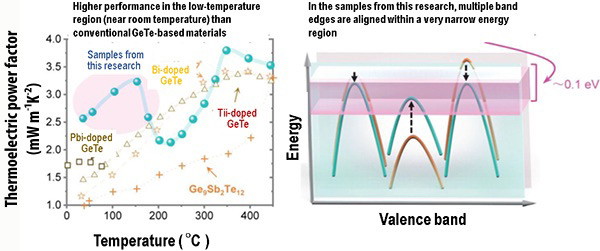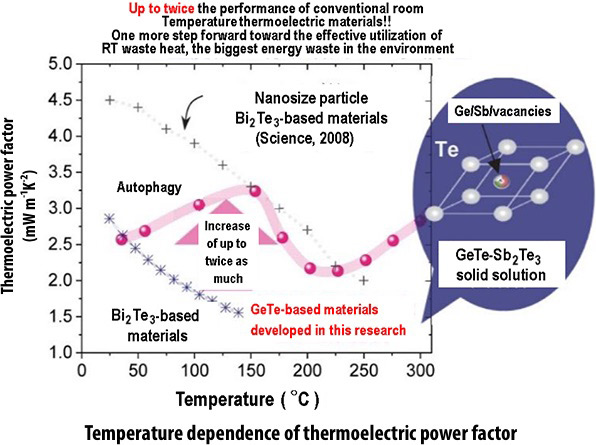Research Results
Potential application to energy harvesting technology that contributes to the IoT society
Precise control of electronic structure that doubles power generation performanceFY2022

- Kosuga Atsuko (Associate Professor, Graduate School of Science, Osaka Metropolitan University)
- PRESTO
- "Scientific innovation for energy harvesting technology"
Development of thermoelectric materials and devices for low-temperature applications (2017-2021)
Highly efficient conversion of room temperature waste heat into electricity
By precisely controlling the electronic structure of a material = germanium telluride (GeTe), which was previously known to exhibit high performance in the high-temperature range, the thermoelectric power factor (*1) near room temperature was successfully increased up to twice that of conventional materials. It was also found that in addition to the conventional valence bands (*2), there is a new valence band that contributes to the improvement of thermoelectric performance. This relates to the elemental technology of waste heat utilization that reuses room temperature waste heat, which accounts for a large amount of all the waste heat in the world, as electricity, and is expected to contribute to the application of energy harvesting technology (*3) and realization of the energy-saving society.
*1 Thermoelectric power factor
A way to measure the energy conversion efficiency of thermoelectric performance. It is expressed as the product of the square of the Seebeck coefficient (thermoelectromotive force per 1°C temperature difference) and the electrical conductivity (a measure of the ease with which electricity flows).
*2 Valence band
An energy band filled with valence electrons in insulators and semiconductors.
*3 Energy harvesting technology
Technology that uses micro energy such as heat, light, and vibration that exist around us to generate electricity.
Effective utilization of waste heat from primary energy, a challenge toward the future
About 70% of primary energy (oil, coal, nuclear power, natural gas, hydropower, geothermal heat, solar heat, etc.) is wasted as waste heat, and utilization of this waste heat is important for the effective use of unused energy. It is known that waste heat near room temperature is often small-scale and thinly dispersed despite its large abundance, and it is difficult to recover except by thermoelectric power generation technology (*4). However, there has been little progress in developing "room temperature thermoelectric materials" that exhibit high thermoelectric properties near room temperature required for recovery of this waste heat, and almost no new materials had been developed that surpass the conventional materials discovered about half a century ago.
*4 Thermoelectric power generation technology
Clean power generation technology that directly converts heat (temperature difference) into electricity. It is suitable for the recovery of small-scale dispersed waste heat using the Seebeck effect, a physical phenomenon of solids in which thermal energy is converted into electrical energy. The materials used in this technology are called thermoelectric materials or thermoelectric conversion materials.
Precise control of the electronic structure of thermoelectric materials
The group has succeeded in increasing the thermoelectric power factor of GeTe (germanium telluride), which was conventionally known as a thermoelectric material showing high performance at 250 to 600°C, at near room temperature (room temperature to 150°C) (Fig. 1, left). From experiments and calculations, it was found that, by making a solid solution (*5) of GeTe with Sb2Te3 (antimony telluride), the performance is improved due to band edge degeneracy (*6) (Fig. 1, right) that is a new valence band edge degeneration in a very narrow energy region, in addition to the valence band already known to improve thermoelectric performance,

Fig. 1
(Left) Temperature dependence of thermoelectric power factor of GeTe solid solution sample and conventional GeTe-based materials
(Right) Schematic diagram of band edge degeneracy of GeTe solid solution sample (light blue curve) and conventional GeTe-based material (brown curve)
(Energy width shown in pink is about 0.1 eV near room temperature. Since this energy width is proportional to the temperature, it is generally more difficult to make multiple band edges degenerate near room temperature than in the high-temperature range).
Normally, in order to achieve an improvement of thermoelectric performance in the room temperature range by such a method, accurate information on the crystal structure and electronic structure of the material are required. However, this material system can have a similar structure that is difficult to distinguish depending on sample preparation conditions and the temperature. Moreover, it was difficult to obtain accurate electronic structure information due to the nature of the solid solution.
High-precision powder diffraction data of the prepared sample was acquired at the powder crystal structure analysis beamline BL02B2 of the large-scale radiation facility SPring-8 (*7), and the crystal structure was investigated. Further, using this as input data, the electronic structure of the sample was calculated. In general, accurate electronic structure calculation is difficult for solid solution like this sample without a huge computation cost, but the computation code has been improved so that now, it can be calculated efficiently and accurately for material systems like this, and thus the electronic structure can be precisely controlled.
The GeTe solid solution sample developed here has a thermoelectric power factor up to twice that of conventional room temperature Bi2Te3 (bismuth telluride), prepared by the same simple sample preparation process as in this study, in the temperature range of room temperature to 150°C (Fig. 2). In addition, as with Bi2Te3, there is a possibility to further improve the thermoelectric performance by optimizing the microstructure using nanoparticles (Fig. 2). By applying the high-performance-achieving principles of this research to other material systems, new room-temperature thermoelectric materials may be discovered from material groups that were not previously considered as room temperature thermoelectric material candidates. This is expected to give fresh impetus to the development of new materials.

Fig.2 Comparison of thermoelectric power factor with conventional materials
*5 Solid solution
A solid in which two or more substances are mixed to form a completely uniform solid phase is called a solid solution. There are two types: the one is for the case where some atoms at lattice points of a crystal phase are replaced by other atoms in a completely irregular manner, and the other, where other atoms invade lattice gaps.
*6 Band edge degeneracy
Aligning the energy positions of the edges of multiple energy bands within a certain energy range is called band edge degeneracy. By increasing the degree of degeneracy, the thermoelectric power factor can be improved. If it is desired to increase the degeneracy in the room temperature range, the degeneracy must be increased within a very narrow energy region as compared with the case of the high-temperature range.
*7 Large-scale radiation facility SPring-8
A large-scale synchrotron radiation facility that produces the world's highest performance synchrotron radiation, situated in the Harima Science Park City of Hyogo Prefecture owned by RIKEN (Hyogo Prefecture Harima Science Park City).
Contributing to the IoT society and energy-saving society
Based on these research results, thermoelectric materials that can be used at room temperature have been developed, and the methods of controlling them have been identified. Applying this to device development will lead to the realization of technology efficiently converting room temperature waste heat, which accounts for a major fraction of all the waste heat in the world, into electricity.
In the future, as a self-sustaining power source for micro-energy harvesting that supports the sensor network society advocated by Society 5.0 (*8), it is expected to contribute to the coming IoT (Internet of Things) society, and as a means of using energy more effectively, to the realization of an energy-saving society.
In addition, the materials obtained here are expected to greatly contribute to resource-saving strategies as alternatives using germanium, which is about 30 times more plentiful than the rare metal bismuth.
*8 Society 5.0
A human-oriented society that realizes both economic development and solutions to social issues through a system that highly integrates cyberspace and physical (reality) space.
- Environment and Energy
- Research Results
- Japanese
